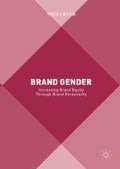Abstract
This chapter discusses the important question of whether the brand-gender–brand-equity model is a simple fallacy. This could be true for several reasons, such as missing invariance, particularly in cross-cultural studies, and common method or common source biases. Respective tests support the assumption that the global data were form-, metric-, and scalar-invariant, providing evidence that the model measured gender and equity consistently across all countries. The data presented in this book were assessed for brand genders and equities in only one common survey. This means that the same people rated gender and equity items. Since individuals have their own response styles, it could be that those who tended to give high ratings on scales did so for both gender and equity items. The same could hold for respondents who tended to give low ratings on scales. Because of this, a positive correlation between gender and equity could, in fact, be an invalid artifact. Several sophisticated tests provided evidence that such a common source bias could be widely excluded. Finally, for the first time, the claim that the assignment of human personality traits to brands is appropriate only if the personality traits load under the same factors for both humans and brands was tested. Gender scores were assessed not only for brands, but also for several human portraits. In a multi-group analysis, the same factors emerged and the measurements of brands and persons were invariant, supporting the overall validity of the brand-gender–brand-equity approach.
Access this chapter
Tax calculation will be finalised at checkout
Purchases are for personal use only
References
Aaker, Jennifer L. 1997. Dimensions of Brand Personality. Journal of Marketing Research 34 (3): 347–356. doi:10.2307/3151897.
Austin, Jon R., Judy A. Siguaw, and Anna S. Mattila. 2003. A Re-Examination of the Generalizability of the Aaker Brand Personality Measurement Framework. Journal of Strategic Marketing 11 (2): 77–92. doi:10.1080/0965254032000104469.
Azoulay, Audrey, and Jean-Noel Kapferer. 2003. Do Brand Personality Scales Really Measure Brand Personality? The Journal of Brand Management 11 (2): 143–155.
Baumgartner, Hans, and Jan-Benedict E.M. Steenkamp. 2001. Response Styles in Marketing Research: A Cross-National Investigation. Journal of Marketing Research 38 (2): 143–156. doi:10.1509/jmkr.38.2.143.18840.
Bollen, Kenneth A. 1989. Structural Equations with Latent Variables. New York: Wiley.
Brace, Ian. 2008. Questionnaire Design—How to Plan, Structure and Write Survey Material for Effective Market Research, 2nd ed. London & Philadelphia: Kogan Page.
Brannick, Michael T. 1995. Critical Comments on Applying Covariance Structure Modelling, 16 (December 1994), 201–214.
Burt, Cyril. 1940. The Factors of the Mind. London: University of London Press.
Byrne, Barbara M. 2004. Testing for Multigroup Invariance Using AMOS Graphics: A Road Less Traveled. Structural Equation Modelling: A Multidisciplinary Journal 11 (2): 272–300. doi:10.1207/s15328007sem1102_8.
Caprara, Gian Vittorio, Claudio Barbaranelli, and Gianluigi Guido. 2001. Brand Personality: How to Make the Metaphor Fit? Journal of Economic Psychology 22: 377–395. doi:10.1016/S0167-4870(01)00039-3.
Cheung, Gordon W., and Roger B. Rensvold. 2000. Assessing Extreme and Acquiescence Response Sets in Cross-Cultural Research Using Structural Equations Modeling. Journal of Cross-Cultural Psychology 31 (2): 187–212. doi:10.1177/0022022100031002003.
Chang, Sea-Jin, Arjen van Witteloostuijn, and Lorraine Eden. 2010. From the Editors: Common Method Variance in International Business Research. Journal of International Business Studies 41 (2): 178–184. doi:10.1057/jibs.2009.88 (Palgrave Macmillan).
Churchill, Gilbert A. 1979. A Paradigm for Developing Better Measures of Marketing Constructs. Journal of Marketing Research 16 (1): 64–73. doi:10.2307/3150876.
de Jong, Martijn G., Jan-Benedict E.M. Steenkamp, Jean-Paul Fox, and Hans Baumgartner. 2008. Using Item Response Theory to Measure Extreme Response Style in Marketing Research: A Global Investigation. Journal of Marketing Research 45 (1): 104–115. doi:10.1509/jmkr.45.1.104.
Equitrend. 2013. Harris Poll EquiTrend. http://www.harrisinteractive.com/Products/EquiTrend.aspx.
Freling, Traci H., and Lukas P. Forbes. 2005. An Examination of Brand Personality through Methodological Triangulation. Journal of Brand Management 13 (2): 148–162. doi:10.1057/palgrave.bm.2540254.
Gove, Walter R., and Michael Hughes. 1980. Reexamining the Ecological Fallacy: A Study in Which Aggregate Data Are Critical in Investigating Pathological Effects of Living Alone. Social Forces 58 (4): 1157–1577.
Grohmann, Bianca. 2009. Gender Dimensions of Brand Personality. Journal of Marketing Research 46 (1): 105–119. doi:10.1509/jmkr.46.1.105.
Harman, Harry H. 1976. Modern factor analysis, 3rd ed. Chicago, IL: The University of Chicago Press.
Organ, Dennis W., and Katherine Ryan. 1995. A Meta-Analytic Review of Attitudinal and Dispositional Predictors of Organizational Citizenship Behavior. Personnel Psychology 48 (4): 775–802. doi:10.1111/j.1744-6570.1995.tb01781.x.
Podsakoff, Philip M., Scott B. MacKenzie, Jeong-Yeon Lee, and Nathan P. Podsakoff. 2003. Common Method Biases in Behavioral Research: A Critical Review of the Literature and Recommended Remedies. Journal of Applied Psychology 88 (5): 879–903. doi:10.1037/0021-9010.88.5.879.
Robinson, W.S. 1950. Ecological Correlations and the Behavior of Individuals. American Sociological Review 15 (3): 351–357.
Steenkamp, Jan-Benedict E.M., and Hans Baumgartner. 1998. Assessing Measurement Invariance in Cross-National Consumer Research. Journal of Consumer Research 25 (1): 78–107. doi:10.1086/209528.
Stewart, David W. 1981. The Application and Misapplication of Factor Analysis in Marketing Research 18 (1): 51–62. doi:10.2307/3151313.
Tucker, Ledyard R., and Charles Lewis. 1973. A Reliability Coefficient for Maximum Likelihood Factor Analysis. Psychometrika 38 (1): 1–10. doi:10.1007/BF02291170.
Williams, L.J., N. Hartman, and F. Cavazotte. 2010. Method Variance and Marker Variables: A Review and Comprehensive CFA Marker Technique. Organizational Research Methods 13 (3): 477–514. doi:10.1177/1094428110366036.
Author information
Authors and Affiliations
Corresponding author
Rights and permissions
Copyright information
© 2018 The Author(s)
About this chapter
Cite this chapter
Lieven, T. (2018). The Effect of Brand Gender on Brand Equity—A Simple Fallacy?. In: Brand Gender. Palgrave Macmillan, Cham. https://doi.org/10.1007/978-3-319-60219-6_12
Download citation
DOI: https://doi.org/10.1007/978-3-319-60219-6_12
Published:
Publisher Name: Palgrave Macmillan, Cham
Print ISBN: 978-3-319-60218-9
Online ISBN: 978-3-319-60219-6
eBook Packages: Business and ManagementBusiness and Management (R0)

